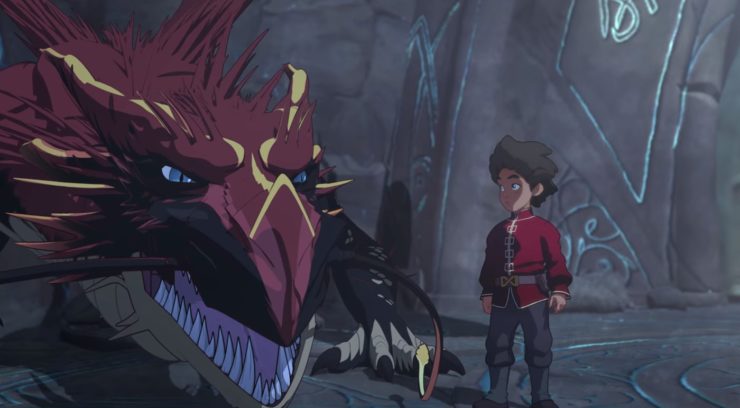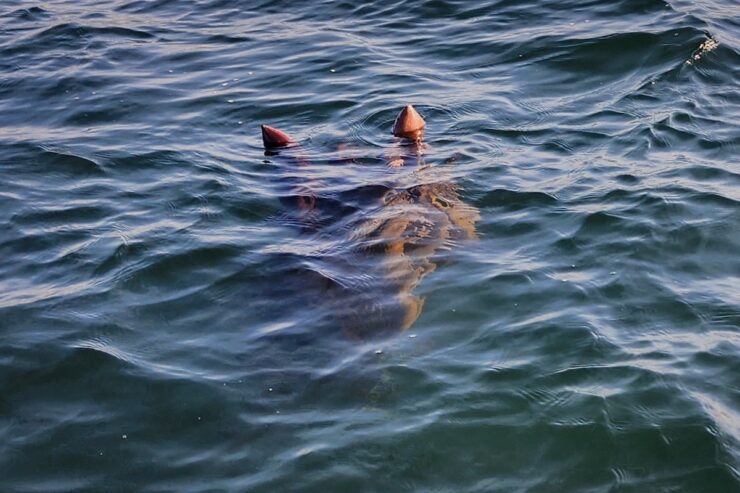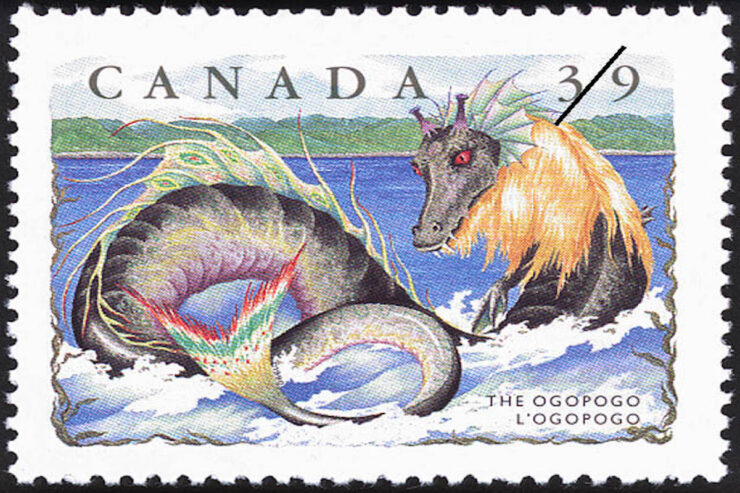In general I’m not an animated-series person, or much of a fan of cartoons in general. Hard of hearing child in the days before closed captioning, which rendered that medium inaccessible. But it’s the future now. When I read a review of the Netflix series The Dragon Prince that mentioned its Sign-speaking Deaf character and praised its overall quality (not surprising since it comes from the creator of The Last Airbender), I had to try it.
I was hooked. It’s a deeply humane, beautifully constructed story with lovely and compelling characters.
The character who brought me to it plays a strong supporting role as the aunt of the two brothers around whom the story revolves, and she’s a military commander. She has aides who interpret for her. No one treats her differently; she’s not defined by disability. Her deafness is just part of who she is.
There are so many things that I could say about this series. Three seasons are out, and a fourth is coming in November. But this is SFF Bestiary, and I’ve been talking about dragons. The heart of the story is the King of Dragons who was hunted and killed by humans with a very mixed set of motives, and the egg that contains his heir, which the human mage claims to have destroyed, but (NOT MUCH OF A SPOILER) actually kept for its potential as a weapon.
What happens to the egg is a long and complex saga. Humans and elves fight a bitter war that has caused their continent to be divided in half, with one half reserved for humans and the other half for magical beings. The war itself began with the discovery of Dark Magic by a human mage: a kind of magic that requires the draining of magic from a magical being in order to work.
The magical beings of the world have condemned the whole of humanity for that one man’s transgression, but humans have fought back, with horrific consequences on both sides. Many lives lost. Many deadly misunderstandings, and a legacy of fear and hate.
The Dragon Prince is the heir of the most powerful magical being in the world. If he’s allowed to live, everything will change. Enter a pair of human princes and a family of human mages, and an elven assassin who is part of a plot to kill the princes’ father. Their journey across this world and their quest to either save or destroy the egg takes them through a wide range of landscapes both magical and mundane, and introduces them (and us) to a whole bestiary of magical creatures.
Dragons, of course. They are all winged and they all fly. The King and Prince and the Queen of Dragons are storm dragons: silver-blue, white-maned, who shoot off lightning rather than flame. There are also golden fiery sun dragons including the tragic, blinded Sol Regem (Latin being the magical language of this world), and various other species, one of which is the red dragon who flames the human town and is shot down by Dark Magic. They are all intelligent, and the royal dragons can speak in human and elvish languages. Humans hate and fear them. Elves regard them as allies and equals; it was a council of elves and dragons that condemned the world to be split and humans to be confined to one section of it.
On the human side, we see horses, of course, this being a preindustrial society. Horses run like machines, can gallop for days without food or water, and have little or no apparent intelligence. They’re equipment—though there is the arrogant outland prince’s horse with the kind eyes, who gets no reward for that kindness.
The only other non-magical creature (aside from spotted deer) is rather mythical even so: the giant wolf Ava, who loses a leg to a trap as a cub, and becomes the partner and mount of the young hunter Ellis. Ava and Ellis play a key role in the first season, helping the two princes and their elvish ally with the dragon’s egg. She introduces them to a very important character, Lujanne the elf mage.
Lujanne takes us straight into mythical territory. Her companion and mount is a Phoenix. This magical bird doesn’t talk, but she clearly understands human and elvish speech, and she risks her life to help protect the egg and its contents. It’s lovely how much she manages to say, and how clear she is about it, without ever speaking a word.
Most of the animals in the series, now I think about it, are riding animals. That includes dragons. The Moonstriders are more like canines than anything else, like magical versions of Ava.
The ambler is an intriguing creation: absolutely huge, with feet like a giant elephant’s, but the overall shape is somewhat camel-like and somewhat I don’t know what, with a huge spatulate tail that serves as a platform for people to be lifted on and off the creature’s lofty back. It has no personality to speak of; it paces ponderously across the Midnight Desert, pretty much ignoring anything it meets, though it’s sort of vaguely steerable when it feels like it.
It’s one of the most truly alien creatures in the series. On the other end of the size and personality spectrum is Prinze Ezran’s pet and constant companion, Bait the glowtoad. Bait is not so much toadlike as blobby and splotchy. He changes color with his mood, is generally grumpy but occasionally almost cheerful, and once in a while does something that tends toward heroic. He is very loyal. He vocalizes but does not speak; it’s hard to tell how intelligent he is, but I’ve met small to medium dogs with a similar personality. In fact if he were a dog, he’d probably be a middle-aged Pug.
Companion and riding animals aside, there are an assortment of other creatures, some dangerously cute (Adoraburrs, which are basically very sticky tribbles) and some just plain dangerous, including the evil elf mage’s ever-expanding purple worm and the deadly Soulfang Serpents. These in combination with all the varieties of elves and humans have the effect of rounding out the population of the world. It’s a diverse and varied place, beautiful and frequently dangerous. And it’s full to bursting with magic.
As I said, I’m not an animation person. But this series won my heart. I’m there for the dragons and the phoenix, and the wolf and the ambler and the glowtoad, too.
Especially the glowtoad.
Judith Tarr is a lifelong horse person. She supports her habit by writing works of fantasy and science fiction as well as historical novels, many of which have been published as ebooks. She’s written a primer for writers who want to write about horses: Writing Horses: The Fine Art of Getting It Right. She lives near Tucson, Arizona with a herd of Lipizzans, a clowder of cats, and a blue-eyed dog.














